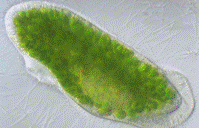Biological Sciences, School of

School of Biological Sciences: Faculty Publications
Document Type
Article
Date of this Version
1995
Citation
Molecular Biology of the Cell, Vol. 6, 611-625, May 1995
Abstract
In Saccharomyces cerevisiae the UPF1 protein is required for nonsense-mediated mRNA
decay, the accelerated turnover of mRNAs containing a nonsense mutation. Several lines
of evidence suggest that translation plays an important role in the mechanism of
nonsense mRNA decay, including a previous report that nonsense mRNAs assemble in
polyribosomes. In this study we show that UPF1 and ribosomal protein Li co-localize in
the cytoplasm and that UPF1 co-sediments with polyribosomes. To detect UPF1, three
copies of the influenza hemagglutinin epitope were placed at the C-terminus. The tagged
protein, UPF1-3EP, retains 86% (± 5%) of function. Using immunological detection, we
found that UPF1-3EP is primarily cytoplasmic and was not detected either in the nucleus
or in the mitochondrion. UPF1-3EP and Li co-distributed with polyribosomes fractionated
in a 7-47% sucrose gradient. The sucrose sedimentation profiles for UPF1-3EP and
Li exhibited similar changes using three different sets of conditions that altered the
polyribosome profile. When polyribosomes were disaggregated, UPF1-3EP and Li accumulated
in fractions coincident with 80S ribosomal particles. These results suggest that
UPF1-3EP associates with polyribosomes. L3 and S3 mRNAs, which code for ribosomal
proteins of the 60S and 40S ribosomal subunits, respectively, were on average about
100-fold more abundant than UPF1 mRNA. Assuming that translation rates for L3, S3,
and UPF1 mRNA are similar, this result suggests that there are far fewer UPF1 molecules
than ribosomes per cell. Constraints imposed by the low UPF1 abundance on the
functional relationships between UPF1, polyribosomes, and nonsense mRNA turnover
are discussed.


Comments
Copyright 1995 by The American Society for Cell Biology